
The stock mixture per 96-well plate consisted of 5 µL of each antibody in 15 mL of PBS. To each well, 150 µL of a stock mixture containing mouse anti-FLAG primary antibody, anti-mouse Alexa 488 secondary antibody, and PBS mixture was added. Each plate included positive and negative controls: a negative unstained control, a solvent control (1% DMSO), a stained control with no chemical for background staining, and a positive staining control (HIV Env-wt in the presence of DCK). Cells were incubated in the presence of chemicals for 48 h, and analyzed for cytotoxicity and auto-fluorescence before staining. 3.0×10 4 cells in 90 µl were then transferred into each well with a MultiDrop 384 (Thermo Scientific, Waltham, MA) to bring the final concentration of chemicals to 10 µM in 100 µL growth media. Ten microliters of the stock were transferred into 96-well plates for screening. The 96-well plate at 100 µM served as stock for further copies of the library. Preparation of Library and HTS: The original PCL, provided in 384-well plates at 1 mM, was copied into 96-well plates at 100 µM (10 µl of the original library into 100 µl).

However, few platforms exist for multiplexed screening applications and are often adapted to more biochemical approaches rather than live cell-based platforms. In addition, many platforms seek to multiplex to analyze drugs against similar targets simultaneously, reducing cost, time, and material. Many current high-throughput technologies use cell-based assays to provide a more natural context for drug–target interactions as well as to address cytotoxicity. Improving assay and screening technologies will certainly help identify better hit–lead compounds, thus reducing the cost involved in subsequent stages of drug development. However, most putative drug hits fail at later stages of development and/or implementation, and few hits actually become leads. The growing technological capabilities of better and faster instrumentation coupled to assays both in vitro and ex vivo have had a huge impact on high-throughput screening (HTS) platforms that have propelled scientific and drug discoveries. We describe for the first time a cell-based assay that monitors DenV prM processing within the classical secretory pathway, which was exploited to identify a potential novel drug against DenV. A pilot screen against 1280 compounds was executed, leading to the identification of a potential active and corroborating the robustness of our assay for large-scale screening. The assay, miniaturized into a 96-well plate format, was multiplexed with the HIV-1 envelope boundary, also cleaved in the same pathway.


The assay discriminates between a single cell-surface tag when prM is cleaved and two tags when it is not, as detected through fluorescent-coupled antibodies by flow cytometry. We have thus established a cell-based platform to monitor prM processing that relies on an engineered two-tag scaffold that travels to the cell surface through the secretory pathway. Blockade of prM cleavage would restrict fusion and represents a novel druggable opportunity against DenV. prM molecules in immature particles are cleaved by host proteases, leading to mature fusogenic virions. The DenV pre-membrane protein (prM) is a crucial chaperone for the viral envelope protein, preventing premature fusion with vesicles during viral export.


 0 kommentar(er)
0 kommentar(er)
